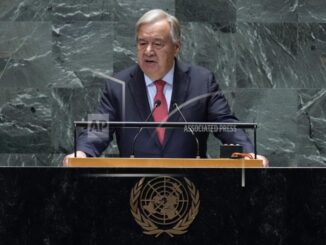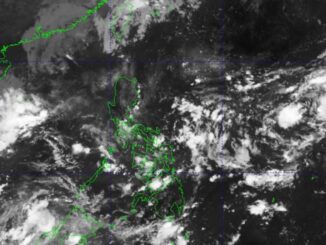
(UPDATES) METRO Manila was placed under a state of calamity on Wednesday after relentless rain drenched large areas of the country, triggering floods in the National Capital Region and landslides in mountainous regions as Typhoon Carina intensified the seasonal monsoon.
“Metro Manila is now in a state of calamity,” said Local Government Secretary Benhur Abalos after a meeting with the Metro Manila Council.
Twelve of the 17 Metro Manila mayors voted to declare the state of calamity, which unlocks funds for relief efforts; the remaining five were unable to attend the meeting.
WATERY WORLD A man carrying a plastic container wades through a flooded street in Manila on July 24, 2024 amid heavy rains. AFP PHOTO
The state weather forecaster, which reclassified Carina as a “super typhoon” as it exited the country, warned of “serious flooding” in some areas.
In the densely populated capital, rescuers were deployed across the city to help evacuate people from low-lying homes after downpours turned streets into rivers, trapping vehicles.
People clutched flimsy umbrellas as they waded through thigh-deep, murky water or used small boats and shopping trolleys to move around.
“The disturbance it caused is great. The waters reached the second floor of our house,” Nora Clet, a homemaker, said.
Restaurant employee Rex Morano said he wasn’t able to work due to the “very high” floodwaters.
Government offices were shut and classes suspended; at least 80 domestic and international flights were canceled; and tens of thousands of customers lost power because of the weather.
Some shopping malls offered temporary shelter to people affected.
“Many areas are flooded, so we have rescuers deployed all over the city. There is an overwhelming number of people asking for help,” Peachy de Leon, a disaster official in suburban Manila, said.
“We were told last night the rain would not hit us, then the rain suddenly poured, so we were quite shocked. There is an ongoing search and rescue now.”
Typhoon Carina, which has swept past the Philippines as it heads toward Taiwan, intensified the southwest monsoon rains typical for this time of year, the state weather forecaster said.
“Usually the peak of rainy season is July and August, and it so happens that there is a typhoon in the eastern waters of the Philippines that enhances the southwest monsoon,” senior weather specialist Glaiza Escullar said.
More than 200 millimeters (nearly 8 inches) of rain fell in the capital in the past 24 hours, Escullar said, which was “not unusual.”
More heavy rain was expected on Thursday.
Landslides killed a pregnant woman and three children in Batangas province, south of Manila, and blocked three major roads in the mountainous Benguet province, police and disaster officials said on Wednesday.
That takes the death toll from heavy rains over swaths of the country in the past two weeks to at least 12, as tens of thousands sheltered in evacuation centers.
President Ferdinand Marcos Jr. on Wednesday ordered disaster response officials to ensure they had sufficient stockpiles of food for the hardest-hit areas because “their situation is critical.”
Hard-scrabble neighborhoods near Manila Bay were badly affected, with most of the streets under water and more than 2,000 people forced to flee their homes.
During a briefing at the National Disaster Risk Reduction and Management Council (NDRRMC) Headquarters in Camp Aguinaldo, Quezon City, Marcos ordered all government agencies to focus on “critical areas” that were severely affected by the heavy rains.
“Our response so far has been good. I just told them to focus carefully on those areas that are isolated,” Marcos told reporters.
The President directed the Department of Social Welfare and Development (DSWD) to continue assisting those affected by the typhoon and to work with the Office of the Civil Defense (OCD) to immediately identify critical areas.
He also emphasized the importance of the immediate conduct of search and rescue operations for trapped residents and the distribution of relief assistance to affected individuals once the weather permits.
As of Wednesday noon, the DSWD recorded a total of 45,328 families affected in 225 barangay (villages) in Regions 1 (Ilocos Region), 2 (Cagayan Valley), 3, Calabarzon (Region 4A), Mimaropa (Region 4B), 5 (Bicol Region), 6 (Western Visayas), 7 (Central Visayas), National Capital Region, and Cordillera Administrative Region.
There are 1,702 families, or 6,524 individuals, taking shelter in 126 evacuation centers in various regions.
During the briefing with the President, OCD Operations Service Director Cesar Idio said the agency would map communities that were isolated due to the typhoon.
Idio said that a total of 96 road sections and 13 bridges were affected nationwide due to heavy rains and landslides caused by Carina and the monsoon.
A total of 423 areas had also been submerged in floodwaters, of which 117 remained inundated in Region 3, Region 4A, Region 4B, Region 9 (Zamboanga Peninsula), Region 10 (Northern Mindanao), and Bangsamoro Autonomous Region in Muslim Mindanao (BARMM).
Meanwhile, floods in 281 areas in Regions 4A, 5B, Region 7, Region 9, Region 10, Region 11 (Davao), Region 12 (Soccsksargen) and BARMM have already subsided, while floods in 25 other areas in Regions 7, 9, 12 and BARMM were already receding.
The NDRRMC also reported that a total of 882,861 individuals (183,464 families) have already been affected by Carina, the habagat, and the tropical storm Butchoy.
More than 612,000 individuals (123,000) families have been displaced by the three weather systems since July 18.
The NDRRMC said it was validating four deaths that were recorded by local authorities due to a landslide in Agoncillo, Batangas.
Four passengers in a white car that plunged into a creek on the perimeter of Camp Crame in Quezon City were still missing hours after the incident.
Meanwhile, Marcos ordered concerned government agencies to warn communities first before releasing water from dams, especially in Luzon, to avoid accidents and loss of lives.
The President said the NDRRMC must avoid leaving the people uninformed about the release of water from dams and help them evacuate as soon as possible.
“Let us avoid that. It is not enough to just advise them. We need to send vehicles to evacuate them. Bring them to evacuation centers,” Marcos said.
In his report during the briefing, Abalos said large parts of the low-lying cities in Metro Manila are submerged in floodwaters, noting that 70 percent of areas in Navotas City are flooded, 80 percent in Malabon City, and 60 percent in Valenzuela City.
The President assured the public that the government was already working on the funds the LGUs could access under a state of calamity.
He said even those outside evacuation centers would get their needed help.
Social Welfare and Development Secretary Rex Gatchalian ordered the dispatch of family food packs and other relief items to typhoon-hit communities.
A DSWD official said the department has about 1 million family food packs, with a standby fund and stockpile fund of about P2.6 billion.
In response to the widespread flooding, Malacañang suspended work in government offices and classes at all levels in Metro Manila on Wednesday, effective 5 a.m.
The suspension of work for private companies and offices was left to the discretion of their respective heads.
As Carina exited and was about to make landfall over northern Taiwan, the state weather bureau reclassified it as a super typhoon.
Packing maximum sustained winds of 185 kilometers per hour (kph) near the center and gustiness of up to 230 kph, the super typhoon was moving northwestward at the speed of 20 kph, the weather bureau said in its 5 p.m. bulletin.
The center of the eye of Carina was estimated at 380 km north of Itbayat, Batanes, the agency said.
WITH CATHERINE S. VALENTE, FRANCISCO TUYAY, MOISES CRUZ, FREDERICK SILVERIO, ARLIE O. CALALO, AND AFP





Be the first to comment